In this post, we will check out the top 10 best football stadiums in the world in 2024.
In the dynamic world of football, the stadium is not just a venue; it’s an emblem of heritage, pride, and unforgettable moments.
As we step into 2024, the architectural marvels that host the beautiful game have evolved into more than mere structures—they are hubs of cultural convergence, innovation, and passion.
This article delves into the top 10 best football stadiums in the world in 2024, celebrated not only for their architectural brilliance and capacity but also for the extraordinary atmosphere they cultivate and the historical moments they’ve hosted.
From the echoing roars of passionate fans to the cutting-edge facilities that cater to every spectator’s need, each stadium on our list offers a unique experience that transcends the ordinary.
These iconic venues are selected based on a myriad of criteria, including fan experience, architectural design, sustainability, and the legacy they hold in the football world.
Join us as we explore these colossal arenas that are not just stages for the players but sanctuaries for the fans, each telling its own story of glory, triumph, and the undying love for football.
Top 10 Best Football Stadiums In The World 2024
10 Red Bull Arena

Nestled in the heart of Leipzig, Germany, the Red Bull Arena stands as a modern testament to football’s evolving landscape.
Originally constructed for the 2006 FIFA World Cup, this stadium has since been transformed into a fortress for RB Leipzig, a club that has rapidly ascended the ranks of European football.
With a seating capacity that accommodates over 40,000 spectators, the arena is designed to offer an intimate yet electrifying matchday experience.
The Red Bull Arena is evident in its retractable roof and the proximity of the seats to the pitch, ensuring fans are always at the heart of the action.
Its design not only enhances the acoustics, amplifying the cheers and chants but also ensures optimal visibility from every vantage point, making every game a memorable spectacle.
Sustainability and accessibility are key features of the arena, reflecting a commitment to environmental stewardship and inclusivity.
Advanced energy management systems and eco-friendly practices are in place to minimize the stadium’s carbon footprint, while ample facilities ensure that it remains welcoming to all fans, including those with disabilities.
Beyond the thrilling matchdays, the Red Bull Arena serves as a community hub, hosting a variety of events and offering tours that give fans a behind-the-scenes look at the stadium’s operations and history.
Its role in the community and the world of football continues to grow, as it sets standards in fan experience, architectural excellence, and sustainable practices, securing its place among the elite football stadiums worldwide.
9 Allianz Stadium
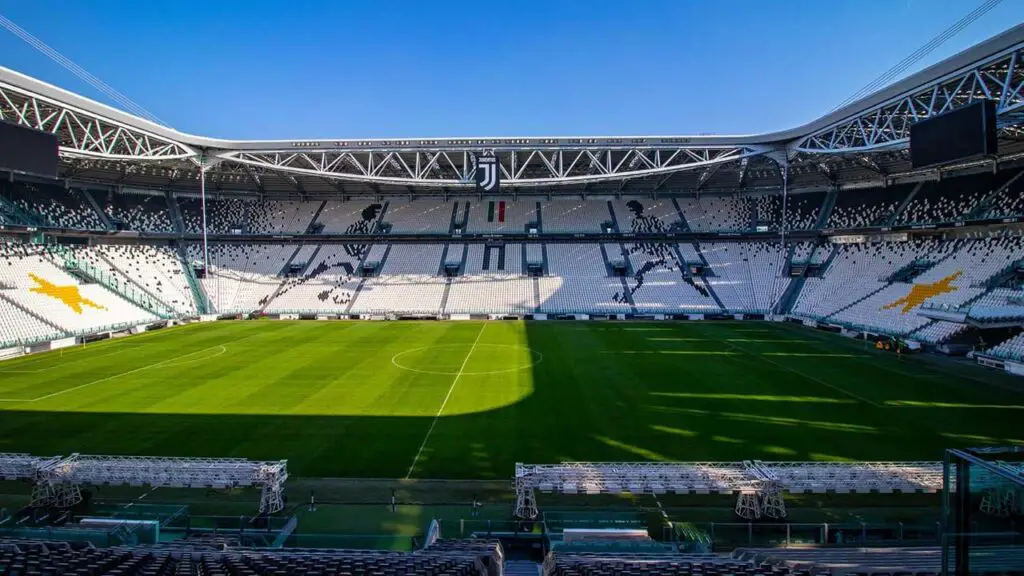
Allianz Stadium emerges as a contemporary icon in the realm of sports architecture. Renowned for being the home of Juventus FC, one of Italy’s most storied football clubs, this stadium exemplifies modernity and innovation in its construction and operation.
With a spectator capacity that reaches approximately 41,000 individuals, it provides an intimate yet intense atmosphere for every event held within its confines.
Allianz Stadium is lauded for its futuristic aesthetics and the way it facilitates an unparalleled viewing experience.
The proximity of the seating to the pitch creates an intense connection between the players and the audience, enhancing the emotional charge of the matches.
Environmental considerations are at the forefront of the stadium’s operational ethos. Initiatives focused on sustainability are evident in its use of renewable energy sources and advanced systems for reducing environmental impact.
The stadium’s infrastructure also prioritizes inclusivity, ensuring accessibility for all fans, regardless of physical ability.
Apart from hosting exhilarating football matches, Allianz Stadium acts as a cultural focal point in Turin, offering guided tours that delve into its architectural nuances and the rich history of Juventus FC.
This multifunctional venue is not only a temple for football aficionados but also a symbol of forward-thinking architectural and environmental practices, cementing its status as a landmark in the global sports landscape.
8 Estádio da Luz

Estádio da Luz, often referred to as the Stadium of Light, is a beacon for football enthusiasts and a proud emblem for SL Benfica, one of Portugal’s premier football clubs.
This magnificent stadium, with a capacity to host over 64,000 spectators, stands as a grand stage for football, offering a compelling blend of tradition and contemporary flair.
Estádio da Luz is notable for its sleek, modern lines and the strategic use of natural light, which floods the arena and creates a lively, inviting atmosphere.
Sustainability is a key aspect of the stadium’s operational philosophy, with numerous initiatives aimed at reducing its environmental footprint and promoting eco-friendly practices.
These efforts reflect a commitment to preserving the environment while delivering a top-tier sporting experience.
Estádio da Luz is more than just a venue for football matches; it’s a cultural landmark that offers insights into the history and spirit of SL Benfica and Portuguese football.
Through stadium tours and events, visitors can explore the rich heritage and dynamic presence of this iconic institution.
7 Emirates Stadium

Emirates Stadium is a cornerstone for Arsenal FC, showcasing a blend of modern design and sporting spirit.
This impressive arena, capable of hosting up to 60,000 spectators, is celebrated for its state-of-the-art facilities and distinctive architecture that encapsulates the essence of contemporary sports venues.
The stadium’s design emphasizes openness and light, featuring vast concourses and a facade that integrates glass and metal to striking effect.
Inside, the seating is arranged to ensure that attendees feel close to the pitch, fostering a sense of unity and engagement with the action unfolding before them.
In line with a commitment to the environment, Emirates Stadium incorporates various green initiatives, focusing on energy efficiency and waste reduction.
These measures underscore the venue’s dedication to sustainability and its role as a responsible member of the community.
Beyond its primary function as a venue for exhilarating football matches, Emirates Stadium serves as a cultural point of interest in London.
It offers educational tours that provide insights into the stadium’s architecture, the history of Arsenal FC, and the operational aspects of running a major sports venue.
6 Etihad Stadium
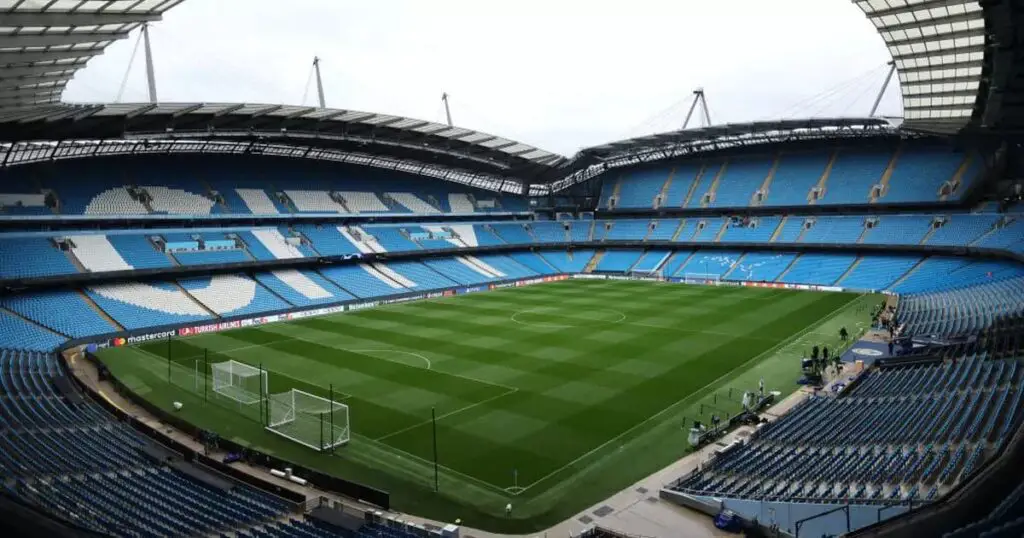
Etihad Stadium is a pivotal home for Manchester City FC, reflecting cutting-edge architecture and the pulsating energy of football.
This grandiose structure can house up to 55,000 spectators, providing an electrifying ambiance for every event it hosts.
The stadium’s design is a testament to modern engineering, featuring sweeping curves and an innovative use of materials that create a visually stunning exterior. Inside, the thoughtful layout ensures optimal sightlines, enabling fans to capture every moment of the action on the field.
Etihad Stadium is at the forefront of eco-friendly practices, implementing measures aimed at reducing its ecological footprint.
These initiatives highlight the stadium’s role as a proponent of environmental stewardship within the sports community.
Beyond serving as a battleground for football, Etihad Stadium is a hub of activity and engagement, offering tours that delve into its architectural marvels and the rich legacy of Manchester City FC.
These experiences provide a deeper understanding of the stadium’s significance in the sports domain.
5 Johan Cruyff Arena
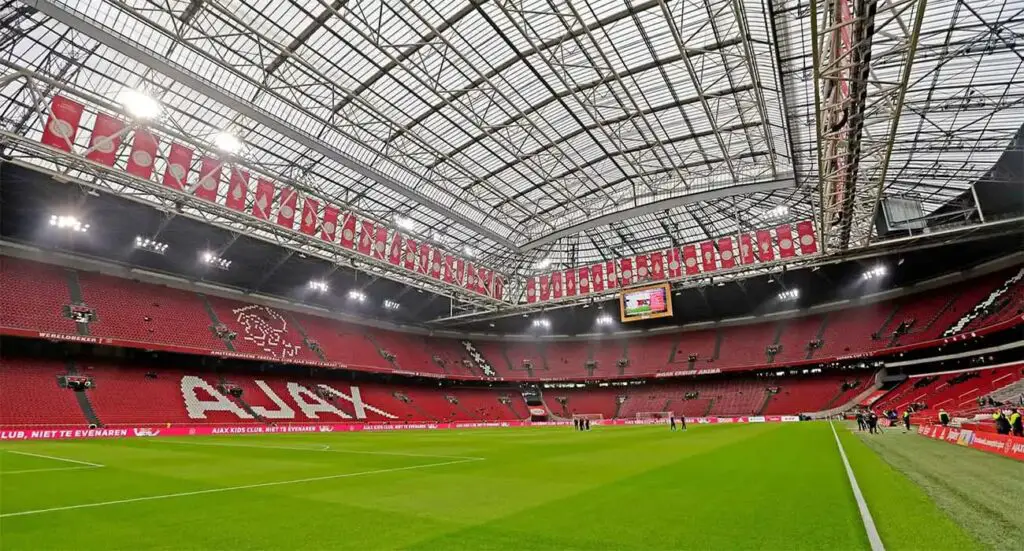
Johan Cruyff Arena is a distinguished venue, serving as the heartland for AFC Ajax. This stadium, with a capacity to accommodate over 54,000 fans, is a tribute to one of football’s greatest legends, Johan Cruyff, and stands as a beacon of innovation and excellence in the realm of sports facilities.
The interior layout is meticulously crafted to provide spectators with a seamless and engaging viewing experience, ensuring that each seat offers a clear and unimpeded view of the pitch.
The Johan Cruyff Arena is a pioneer in environmental sustainability, integrating advanced technologies and practices to minimize its carbon footprint and promote green energy use.
These efforts underscore the stadium’s commitment to ecological responsibility and its role as a leader in sustainable venue management.
Apart from hosting thrilling football matches, the arena is a versatile space that accommodates a variety of events, including concerts and corporate gatherings.
It also offers visitors the opportunity to explore its facilities through comprehensive tours, providing insights into its operational intricacies and historical significance.
4 Allianz Arena
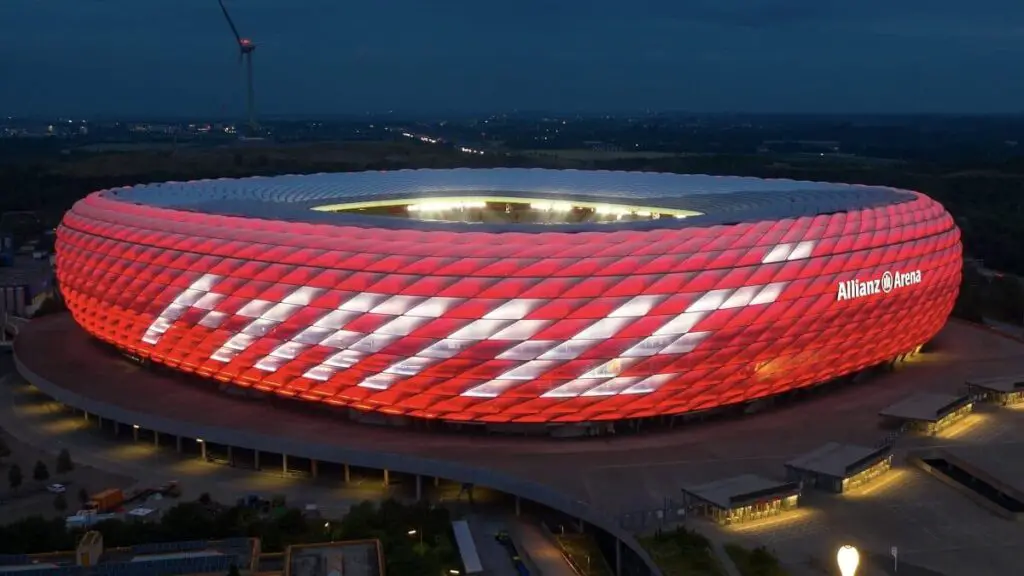
Allianz Arena is a renowned football stadium, primarily serving as the home ground for FC Bayern Munich.
This masterpiece can host approximately 75,000 spectators, making it one of Germany’s largest stadiums and a prominent feature on the international sports map.
The exterior of the Allianz Arena is particularly striking, characterized by its unique facade made of inflated ETFE plastic panels, which can illuminate in a variety of colors, creating a mesmerizing visual display.
This innovative design not only sets the stadium apart aesthetically but also contributes to its recognition as a landmark in architectural design.
Inside, the arena boasts an impeccable layout that ensures an intimate and engaging atmosphere, with strategically positioned seating that offers excellent views of the pitch from all angles.
The stadium’s acoustics are designed to enhance the cheers and chants of the crowd, amplifying the intensity of matchday experiences.
The Allianz Arena is also notable for its commitment to green practices, incorporating various sustainable features to reduce its environmental impact. This commitment reflects a broader trend in stadium management, emphasizing the importance of eco-conscious operations.
For fans and visitors, the stadium offers tours that provide an in-depth look at its architectural features, operational functions, and the storied history of FC Bayern Munich.
3 Tottenham Hotspur Stadium
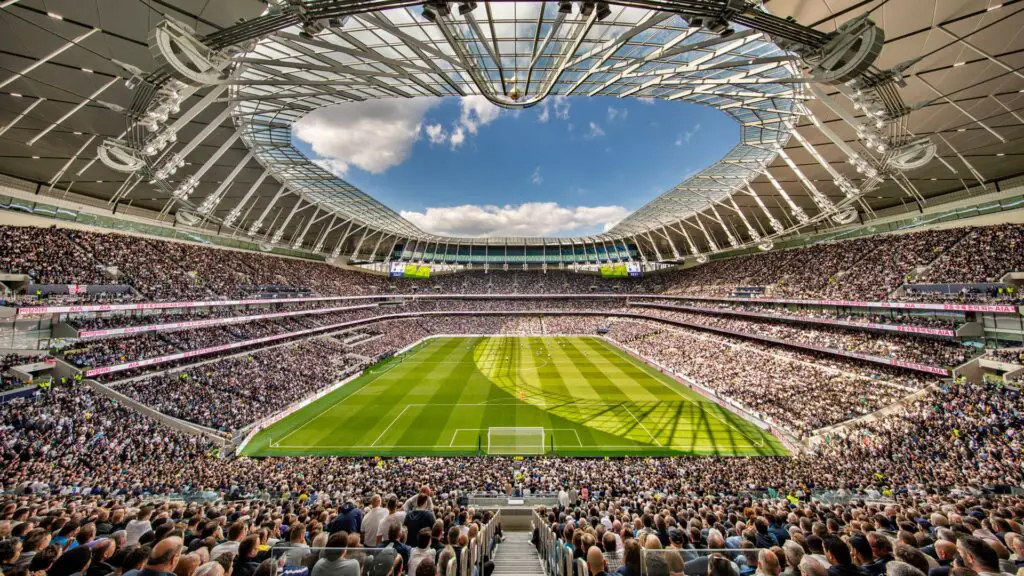
The Tottenham Hotspur Stadium, located in London, England, represents a new era in the architectural and operational standards of sports venues.
As the home ground for Tottenham Hotspur Football Club, this stadium boasts a seating capacity for over 62,000 spectators, making it one of the UK’s most significant and technologically advanced stadiums.
Distinguished by its sleek, contemporary design, the stadium features a distinctive retractable pitch – a groundbreaking feature that allows the venue to host not only football matches but also NFL games and other major events. This versatility showcases the stadium’s innovative approach to design and functionality.
The interior of the Tottenham Hotspur Stadium is crafted to enhance the spectator experience, with steep stands that create an imposing arena atmosphere, ensuring fans are close to the action.
The design prioritizes visibility and comfort, with state-of-the-art amenities and facilities that cater to the needs of every attendee.
Sustainability is a key focus of the stadium’s operation, with initiatives aimed at reducing its environmental impact and promoting sustainable practices. These efforts demonstrate the club’s commitment to environmental stewardship and community responsibility.
2 Camp Nou

Camp Nou, cradled in the heart of Barcelona, Spain, stands as an iconic fortress for FC Barcelona, one of the world’s most celebrated football clubs.
With a staggering capacity to hold over 99,000 spectators, it’s not only the largest stadium in Europe but also a hallowed ground where football legends have been made and history has been written.
This colossal structure is renowned for its immense scale and the intense atmosphere it generates, where the vibrancy of the crowd creates an almost tangible energy.
The design of Camp Nou facilitates a close connection between the players and the audience, fostering a palpable sense of unity and excitement during matches.
Internally, the stadium is equipped with facilities and amenities designed to provide an optimal experience for visitors, whether they are there to watch a match or attend one of the many other events the venue hosts.
The stadium’s layout is meticulously planned to ensure ease of access and comfort, enhancing the overall experience for every visitor.
Camp Nou is not just a venue for sporting events; it’s a symbol of cultural pride and a beacon for football enthusiasts worldwide.
The stadium offers tours that allow fans to explore its depths, from the pitch to the stands, delving into the rich history and legacy of FC Barcelona. Camp Nou is number 2 in our list of top 10 best football stadiums in the world in 2024.
1 Santiago Bernabeu
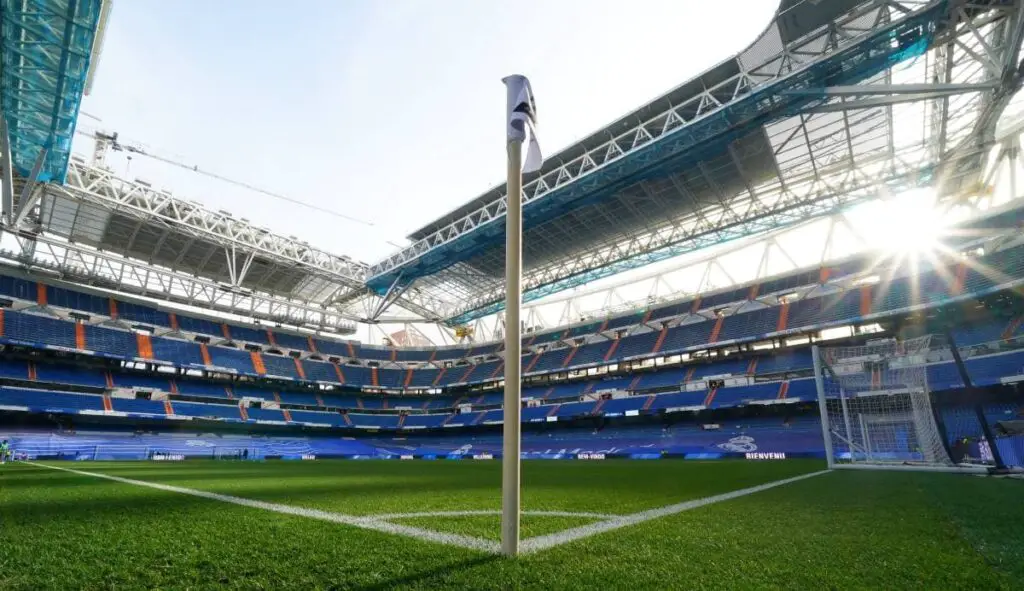
The Santiago Bernabeu is an illustrious stadium that serves as the stronghold for Real Madrid CF, one of the most prestigious football clubs in the world.
This iconic venue, with a seating capacity that exceeds 81,000, is a focal point of global football, attracting fans from every corner of the planet to witness its grandeur.
Renowned for its majestic structure, the Santiago Bernabeu is engineered to offer an immersive viewing experience, with its expansive stands ensuring that each spectator is part of the thrilling action on the field.
The stadium’s architecture is a harmonious blend of tradition and modernity, reflecting its storied past while embracing the future.
Within its confines, the Santiago Bernabeu is outfitted with top-tier amenities and services, aimed at enhancing the comfort and enjoyment of visitors.
From premium seating areas to advanced facilities, the stadium is designed to cater to a diverse audience, ensuring a memorable experience for all.
The Bernabeu is not only a stage for football’s greatest talents but also a venue that hosts a spectrum of events, enriching Madrid’s cultural landscape.
It offers enlightening tours that provide an in-depth exploration of its history, architecture, and the legendary moments that have taken place on its hallowed pitch.
Ultimately, the Santiago Bernabeu stands as a monument to football excellence, embodying the spirit of competition, the joy of the sport, and the legacy of Real Madrid CF. It remains a symbol of footballing prowess, drawing enthusiasts to partake in the extraordinary experiences it offers.
Disclosure: Our content is reader-supported. If you click on certain links we may make a commission. Learn More.
Discover more from Sportshubnet
Subscribe to get the latest posts sent to your email.




